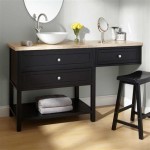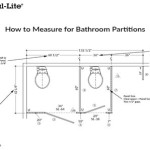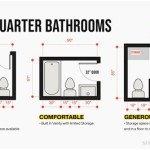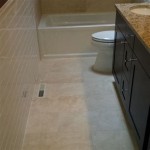Average Bathroom Sink Depth: A Comprehensive Guide
Bathroom sinks are essential fixtures in any residential or commercial space, offering a designated area for washing hands, face, and performing other hygiene-related tasks. One crucial dimension to consider when selecting a bathroom sink is its depth, which significantly impacts functionality, aesthetics, and overall bathroom design. Understanding the average bathroom sink depth and the factors influencing it is vital for making an informed decision that suits individual needs and preferences.
The depth of a bathroom sink refers to the vertical measurement from the highest point of the basin to the lowest point. This dimension directly affects the sink's capacity, the amount of splashback experienced during use, and the overall comfort level for the user. While there isn't one universally defined "average" depth, a range exists that encompasses the majority of bathroom sink models available on the market. This guide will delve into the common depth ranges, the various types of sinks and their typical depths, and the critical considerations that influence the ideal sink depth for a particular application.
Typical Depth Ranges for Bathroom Sinks
The common range for bathroom sink depth generally falls between 5 to 8 inches (approximately 13 to 20 centimeters). Within this range, sinks offer a balance between adequate water capacity and minimizing splashback. A sink shallower than 5 inches might not hold enough water for practical use, leading to frequent refills and potential splashing. Conversely, a sink deeper than 8 inches could be uncomfortable for some users, particularly children or individuals with mobility limitations, as it might require them to lean forward excessively.
It's important to note that these are general guidelines, and variations exist based on the specific sink style and design. For instance, vessel sinks, known for their above-counter installation, often appear deeper due to their elevated position, even if the actual basin depth falls within the standard range. Similarly, trough sinks, typically characterized by their elongated shape and shared basin, may have a shallower depth to accommodate multiple users comfortably.
To further refine the understanding of average sink depth, it's helpful to categorize sinks by their mounting style, as this often correlates with the depth of the basin. The following section will explore the depth characteristics of various sink types.
Sink Types and Their Typical Depths
The type of bathroom sink plays a significant role in determining its depth. Different mounting styles and designs cater to specific aesthetic preferences and functional requirements. Below is a breakdown of common sink types and their associated depth ranges:
1. Undermount Sinks: These sinks are installed beneath the countertop, creating a seamless and clean appearance. Undermount sinks typically have a depth ranging from 5 to 7 inches. The countertop overhang partially conceals the sink's edge, contributing to a sleek aesthetic. Because of their installation method, the effective depth, which considers the countertop thickness, contributes to an overall comfortable reach for the user.
2. Drop-in (Self-Rimming) Sinks: Drop-in sinks are installed into a pre-cut hole in the countertop, with the rim of the sink resting on the countertop surface. Their depth is usually around 6 to 8 inches. The visible rim makes installation relatively straightforward, and these sinks are a popular choice for both new construction and renovations.
3. Vessel Sinks: Vessel sinks are designed to sit on top of the countertop, resembling a bowl or basin. Their depth can vary significantly, ranging from 4 to 8 inches or even more, depending on the design. The overall height of the sink, including the portion above the countertop, contributes to its visual impact and should be considered when selecting faucet height to prevent splashing.
4. Wall-Mounted Sinks: Wall-mounted sinks are attached directly to the wall, freeing up floor space and creating a minimalist look. They typically have a depth of 5 to 7 inches. The absence of a vanity cabinet underneath makes them a good option for smaller bathrooms or for those seeking an accessible design.
5. Pedestal Sinks: Pedestal sinks consist of a sink basin supported by a freestanding pedestal. Their depth usually falls between 6 and 8 inches. While they offer a classic and elegant look, they lack built-in storage, which may be a drawback for some users.
6. Console Sinks: Console sinks combine a sink basin with a supporting frame, often made of metal or wood, providing a more substantial look than pedestal sinks. They typically have a depth of 6 to 8 inches and may offer a small shelf or storage area underneath the sink.
7. Trough Sinks Trough sinks are wide, often rectangular sinks designed for multiple users. They are frequently used in commercial spaces or large bathrooms. Typically, they are shallower than other types of sinks, ranging from 4 to 6 inches in depth to encourage efficient use and minimize water wastage. Since they are designed for multiple users, a shallower design can accommodate a range of heights.
Understanding these depth ranges for different sink types is crucial for making the right decision for your bathroom space. Choosing the right depth can affect the ergonomics and aesthetics of the space.
Factors Influencing the Ideal Sink Depth
Beyond the general guidelines and sink type considerations, several factors influence the ideal sink depth for a specific bathroom. These factors relate to the users of the bathroom, the functionality required, and the aesthetic goals of the design.
1. User Height and Reach: The height of the users is a primary consideration. Shorter individuals, especially children, may find a deep sink uncomfortable to use, requiring them to strain or use a step stool. Conversely, tall individuals may prefer a slightly deeper sink to minimize bending over. A good way to assess this is to measure the distance from the floor to the user's elbow when their arm is bent at a 90-degree angle. The sink depth and countertop height should allow the user to comfortably reach the faucet and basin without excessive bending or straining.
2. Intended Use: The intended use of the sink also influences the ideal depth. A powder room sink, primarily used for handwashing, may require a shallower depth than a master bathroom sink, which might be used for tasks like shaving or washing the face. If the sink is intended for more intensive use, a slightly deeper basin may be preferable to minimize splashing and provide adequate capacity.
3. Bathroom Size and Layout: The size and layout of the bathroom play a role in determining the appropriate sink depth. In a small bathroom, a shallower sink might be preferred to maximize countertop space and create a more open feel. In a larger bathroom, a deeper sink might be suitable without compromising the overall spatial arrangement.
4. Countertop Material and Thickness: The countertop material and thickness also affect the perceived depth of the sink. A thick countertop can effectively increase the overall height of the sink, making a shallower basin more appropriate. Conversely, a thin countertop might necessitate a slightly deeper sink to maintain a comfortable reach.
5. Faucet Selection: The type and height of the chosen faucet should be considered in conjunction with the sink depth. A tall, high-arc faucet paired with a shallow sink can lead to excessive splashing, while a low-profile faucet might not provide adequate clearance over a deep sink. The faucet's reach and water flow should be compatible with the sink's dimensions to ensure optimal functionality and prevent water wastage.
6. Accessibility Considerations: For bathrooms designed to be accessible to individuals with mobility limitations, specific sink depth requirements may apply. The Americans with Disabilities Act (ADA) specifies guidelines for sink height and clearance to ensure ease of use for individuals in wheelchairs or with other mobility aids. These guidelines often necessitate shallower sink depths to allow for comfortable access and minimize reaching.
By carefully considering these factors, individuals can select a bathroom sink depth that not only meets their aesthetic preferences but also provides optimal functionality, comfort, and accessibility.
In addition to the above points, it is important to consider the ease of cleaning when selecting sink depth. Deeper sinks with complex shapes can be more challenging to clean thoroughly, while shallower, simpler designs may be easier to maintain. The material of the sink also influences cleaning requirements, with some materials being more resistant to stains and buildup than others.
Ultimately, the appropriate bathroom sink depth is a personal decision based on individual needs, preferences, and the specific characteristics of the bathroom space. Careful consideration of the factors outlined in this guide will help in making an informed choice that enhances the functionality, aesthetics, and overall enjoyment of the bathroom.

What S The Standard Depth Of A Bathroom Vanity

Ruvati Ariaso 16 In X 11 Bathroom Sink Undermount Gold Polished Brass Stainless Steel Rvh6107gg The Home Depot

American Standard Decorum Vitreous China Wall Hung Rectangle Vessel Sink With 8 In Widespread Faucet Holes White 9134008ec 020 The Home Depot

Native Trails Trough 36 Rectangle Nativestone Concrete Bathroom Sink

What Is The Standard Height Of A Bathroom Vanity

What Is The Standard Height Of A Bathroom Vanity Sizes Cabinets Vessel Sink

Bathroom And Restroom Measurements Standards Guide

Yasinu Sq 36 In W X 18 D Ceramic Vanity Top Integrated Rectangle Basin Sink White Yn2436wh S The Home Depot

Bathroom Sinks China Top Sink For Petite Style Vanities By Diamond Fixtures Kitchensource Com

Rion 36 In White Bathroom Vanity With Composite Granite Top Ceramic Oval Sink And Backsplash De66966 The Home Depot
Related Posts







